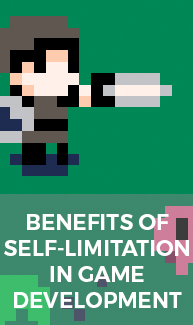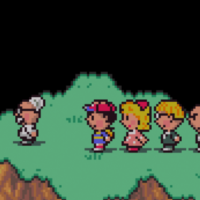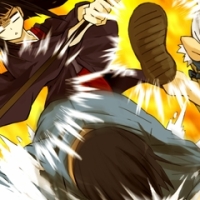
In a way not unlike the failure of Mario Bros. to capture the nuances of the plumbing industry with any sum of accuracy, Nintendo Pocket Football Club is a football management simulation that pushes aside the preconceptions you may have garnered about what’s required to manage a professional football team, in video games or otherwise. It offers a wholly positive take on a career that involves both emotional and economic responsibility, doing away with any of the potentially unattractive realities and concentrating on the sheer act of ‘the beautiful game’ itself.
It’s a satisfying perspective. But what do you expect from a take on a real world practice with the word “Nintendo” in the title?
There has been something of a pattern to my football management career in Nintendo Pocket Football Club. Starting with nothing but a randomly picked assortment of players and a pittance to get off the ground with, it would take two painful seasons of highs and lows for my fledgling side ‘Raijin FC’ (a name intended as a playful take on ‘Raimon’, the titular XI of Level-5’s fantasy football RPG series Inazuma Eleven) to claw its way into the next division up. A small victory to start with, but a victory nonetheless.
The season that followed would be bittersweet to the core. A shot at rubbing shoulders with teams on the cusp of the world stage, missed out on by a total of points you could count on one hand. What would follow, however, was an onslaught. Revenge.
The team had quickly become the footballing equivalent of the figurative fish that’s too big for its pond. We didn’t lose a single game that season, the odd 1-1 draw enough to drag down a consistently perfect rating of fan support; at a glance, perhaps the result of a flawed algorithm at work, but it’s not like real life fans aren’t above such fickleness. No matter, for it wouldn’t be long before they’d get a chance to celebrate again.
Nintendo Pocket Football Club was developed by ParityBit, a studio with a back catalogue of releases that consists almost entirely of entries in the Derby Stallion series of horse racing management games. Their first foray into the world of football came in the form of Calciobit (Calcio coming from the Italian word for football, with the bit provided by the Japanese expression “chobitto”, meaning “a little”. A little bit of football.), released on the Game Boy Advance in 2006 and published by Nintendo. It would not be until 2014 that the game’s enhanced 3DS sequel would reach western shores – but only those of Europe, unsurprising considering the popularity of the sport in question across the continent (a similar trend of football-focused releases skipping a North American release can be seen in Level-5’s aforementioned Inazuma Eleven series).
It’s quite clear why Nintendo would have been drawn to publishing this particular take on a genre known for its complexity and attention to detail. To call Nintendo Pocket Football Club stripped-back would most likely be doing it a disservice, but it offers an undeniably simplistic translation of football management to a virtual form, remarkably more so than the higher profile alternatives. This is true to the extent that the core gameplay systems can be summarised in three parts; managing your team’s lineup and formation, providing limited in-match ‘orders’ and training your players using cards acquired randomly during games.
Degrees of unpredictability, fluctuation and an absence of control permeate nearly every aspect of the game’s design. Systems are portrayed in a way that deliberately obscures their meaning and value as they work behind the scenes; they are made to seem unimportant, whilst quietly determining if you’ll be met with victory or defeat. It appears to be contrarian when considering the norms of the genre, but this approach offers a level of accessibility unparalleled by today’s more speciality-orientated management sims – Nintendo and ParityBit succeeded in recognising an audience excited more by their team’s results and appearance than how much of their budget will be spent on grass maintenance each season.
Raijin and its supporters would be faced with the same pattern again for another two seasons, first narrowly missing promotion (this time thanks to a shock defeat in the play-offs) and later delivering a goal-filled, near perfect series of ninety minute massacres. By the time we’d secured promotion, fan support sat at a momentous 100%, in spite of an early cup exit and a number of late season injuries that had led to typically forward-leaning players sat back in the defensive line. Things were comfortable enough that fielding a weaker team in a league game offered little in the way of concern.
It would seem ungrateful to complain about a 6-0 win in the inaugural game of the following season – even more so when such a triumph came over the team who had made us miss out on promotion almost thirty matches ago. At the time, there was hardly a reason to doubt that this would be our chance to break the two season cycle that had plagued us from the very beginning. The team was in a good place, far more competent than ever before. An increased budget allowed for some new signings – the team’s head coach even went as far as to inform us that there were players in higher leagues eager to join the squad. This was going to be our year, for certain.
Wistfully, it was not meant to be. With great haste, those six goals on opening day became nothing more than a warm, distant memory. They were a fluke.
Charm is of the essence in Nintendo Pocket Football Club, at times in a harsh contrast to the subtle yet brutal challenge of a journey to the top with a penchant for feeling utterly erratic. Stocky, bumbling sprites rush up and down the pitch and collide with one another in a weighty fashion, like bumper cars. Long passes have an almost uncertain air to them, leaving and returning to the earth in graceful, careless arcs.
Players are characterful in their movements, pounding a fist against the grass following a rough challenge or sliding to their knees in celebration with their teammates after scoring a screamer. Elsewhere, these details would likely go unnoticed, or be expected, but it’s the fact that Nintendo Pocket Football Club takes such pride in being streamlined – mechanically and aesthetically – that makes these tiny flickers of personality so delightful to witness. Moments like these work hand-in-hand with the game’s lack of licensed players, entirely to the game’s advantage – you’ll fast grow attached to your squad as the seasons progress.
Lively numbers make up the majority of the game’s soundtrack, emphasising a recurring focus on positivity and fun that perhaps do better to reflect the core values of football than more mainstream video game interpretations of the sport. In contrast, the occasional relaxed, distant tune complements the quieter moments of reflection and calculation that come with management, serving as calming accompaniment to the creativity of designing a new kit, or alternatively providing something of a more sombre note when dismissing experienced players whose moments of glory have long since passed.
The next twenty-nine matches would be a true test. Player training had to grow more intense. I became aware of the ‘potential’ system, a seemingly sporadic gauge that determines when a player has passed their prime by gradually reducing how much their stats can increase in each training session. With training cards a valuable commodity, I learned that it was fruitless to waste them on what the game had deemed to be has-been players.
I was forced to let long-time squad members go to pay the wages of new talent. One in particular, a former star striker who had been with the club from the very beginning, was quickly swept up by the opposition; the day he scored against us would no doubt have been sheer humiliation for the fans. My approval rating, made known after the conclusion of every match, was beginning to shrink week by week.
Out of a mixture of desperation and a feeling of enigmatic responsibility to my artificial fans, I purchased my first and only piece of DLC for the game, the ability to play against a side called ‘Football U’. One of a number of unique lineups that help you more quickly acquire training cards, Football U is described by the game as a team of “swots, nerds and geeks” who “start out with zero football skills, but [are] fast learners”, with each of their player’s skills starting at the lowest possible ranking, gradually increasing as the match progresses. Other downloadable options include a five-member team of super-powered aliens and a team of clones of a player randomly selected from your own squad. The extra resources helped ease some of the virtual managerial pressure, but their perceived necessity only highlighted the struggle I was facing.
As I worked on this article with the game running alongside me on my 3DS, I glanced over just as Raijin’s best forward, Ibáñez, hit one home to give us a 2-0 lead over a CPU-controlled team called ‘Shock Squad’. However, at the very moment the ball crossed the line, one of the opposition’s players tugged at his rival’s shirt, causing the referee to rush over and award a penalty rather than allow the goal. Ibáñez proceeded to miss said penalty.
It’s more complex scenarios such as this that draw to the surface a lack of sophistication in Nintendo Pocket Football Club‘s design. Expectedly, it can be infuriating, but also simply baffling as you’re left wondering why a player would move in a certain way when many superior possibilities look apparent; it’s often seems that these circumstances rarely affect anyone aside from the player’s team, but perhaps this is merely the hopeful delusion of somebody on the losing side.
To play and enjoy Nintendo Pocket Football Club requires acceptance that you are never really in control of your team. This is to be expected to some degree from a management game, but this game in particular extends its minimalistic tendencies far beyond visual presentation. Making substitutions and controlling ‘zones’, which essentially dictate the spacing of your players on the field (smaller zones mean tighter control of the ball, but player stamina depletes at a higher rate), serve as the only methods of influencing your team during a match; there’s not a second of ill-tempered shouting from the sideline to be heard. At times, you might feel like more of a supporter than a manager.
“My choice too!” fans scream in agreement from the stands as I order a substitution in the 73rd minute of the match. Their seemingly unfading faith in my tactical decisions gives me the confidence I need to press on, down by a goal in a game with the potential to secure our safety from relegation. Raijin’s nameless stadium is always packed to the rafters, every supporter donning the club’s striking red and black home shirt in a move that drives me to ponder why my budget for the season isn’t triple the size.
Many elements of your team’s very existence remain a consistent unknown no matter how long your career at the club lasts – who are the mysterious benefactors keeping the team financially afloat? How long have the concrete walls and grass banks that mark the ground’s boundaries stood as a local landmark in the surrounding town? How much are fans paying for pies at half-time? In a different game, these factors could be apparent, maybe even adjustable to a meticulous degree. Nintendo Pocket Football Club doesn’t necessarily ask you to imagine these details, but can very easily encourage you to do so through its aforementioned charm alone.
I was relieved once the final game of the season came around. An upset victory over the leaders had guaranteed our safety, but I was still determined to go out on a high, if only for the fans and the players. Like many other desires that season, this one was not to be fulfilled. My assistant politely insisted that our 6th place finish in a league of eight teams wasn’t as bad as it looked. The mournful frown that graced her pixellated face told an entirely different story.
As a management game, the dedication required to carry a team all the way to glory naturally makes Nintendo Pocket Football Club a tough sell for those lacking some prior interest in the sport in question. However, despite being part of a genre aimed almost entirely at specialists, it’s a game that portrays football in all its innocence, something that calls back to the earliest Nintendo-branded sports games such as Soccer for the NES. For ParityBit, a studio who have dabbled in design bordering on business simulation and who are largely newcomers to designing for a mainstream audience, their success in creating a game that can be both accessible and highly immersive in accordance with the player is deserving of praise.
Nintendo Pocket Football Club is unlikely to sate the managerial appetites of those who have cut their teeth on the likes of Football Manager and take a great deal of pleasure in the control and minutiae of being the boss. This is a football game in which realism is fleeting. It fails to capture every nuance of the sport, but the ones it does draw focus to are the arguably some of the easiest to forget and the most important. Through its simple structure, charming presentation and ability to make you care deeply about 8-bit, made up footballers, Nintendo Pocket Football Club champions a valuable sense of camaraderie, aspiration and – for what it’s worth – passion that should not go unappreciated.
My team had changed an awful lot in five long, fictitious years. In retrospect, my approach as a manager up to this point might have been deserving of being called haphazard. Neglectful, even. Whilst my hard-working players tired themselves out time and time again, I began to find myself better occupied; the game’s near complete absence of player influence during matches made for some ideal multi-tasking opportunities.
Raijin’s time on the pitch doubled as a chance for quick bouts of insect slaughtering action in Earth Defence Force 4.1. More recently, home games served as nothing more than murmuring background ambience during countless hours spent trawling the rich world of The Legend of Zelda: Breath of the Wild – its hidden treasures decidedly more alluring than the secret training combos hidden within Nintendo Pocket Football Club‘s player development system, but ones unlikely to help keep the team away from a vicious collapse back into the third division. Analysing my attitude as the team’s leader reveals what is arguably Nintendo Pocket Football Club‘s greatest divergence from the actual world of football management; a real life team would have had me replaced years ago.
Perhaps next season, victory will be on the menu for Raijin Football Club. For now, I’ll just have to settle for savouring the taste of survival – both for the team and my career.



































Pingback: Review: Nintendo Pocket Football Club (3DS – eShop) ~ Let’s Play This Match | NekoJonez's Gaming Blog